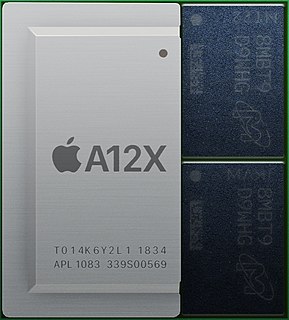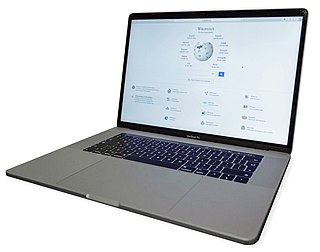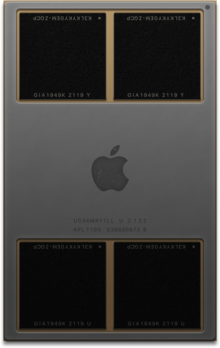
A multi-chip module (MCM) is generically an electronic assembly where multiple integrated circuits, semiconductor dies and/or other discrete components are integrated, usually onto a unifying substrate, so that in use it can be treated as if it were a larger IC. Other terms for MCM packaging include "Heterogeneous integration" or "Hybrid Integrated Circuit". The advantage of using MCM packaging is it allows a manufacturer to use multiple components for modularity and/or to improve yields over a conventional monolithic IC approach.

The MacBook Pro is a line of Macintosh notebook computers by Apple Inc. Introduced in January 2006, it is the higher-end model of the MacBook family, sitting above the consumer-focused MacBook Air. It is currently sold with 13-inch, 14-inch, and 16-inch screens, all using variants of the Apple-designed M1 system on a chip.

Mac Pro is a series of workstations and servers for professionals that are designed, developed and marketed by Apple Inc. since 2006.
AMD Turion is the brand name AMD applies to its x86-64 low-power consumption (mobile) processors codenamed K8L. The Turion 64 and Turion 64 X2/Ultra processors compete with Intel's mobile processors, initially the Pentium M and the Intel Core and Intel Core 2 processors.

The MacBook is a brand of Macintosh notebook computers designed and marketed by Apple Inc. that use Apple's macOS operating system since 2006. It replaced the PowerBook and iBook brands during the Mac transition to Intel processors, announced in 2005. The current lineup consists of the MacBook Air (2008–present) and the MacBook Pro (2006–present). Two different lines simply named "MacBook" existed from 2006 to 2012 and 2015 to 2019.

Apple silicon is a series of system on a chip (SoC) and system in a package (SiP) processors designed by Apple Inc., mainly using the ARM architecture. It is the basis of most new Mac computers as well as iPhone, iPad, Apple TV, and Apple Watch, and of products such as AirPods, HomePod and its successor HomePod Mini, iPod Touch, and AirTag.
Graphics Core Next (GCN) is the codename for a series of microarchitectures and an instruction set architecture that were developed by AMD for its GPUs as the successor to its TeraScale microarchitecture. The first product featuring GCN was launched on January 9, 2012.

Zen is the codename for the first iteration in a family of computer processor microarchitectures of the same name from AMD. It was first used with their Ryzen series of CPUs in February 2017. The first Zen-based preview system was demonstrated at E3 2016, and first substantially detailed at an event hosted a block away from the Intel Developer Forum 2016. The first Zen-based CPUs, codenamed "Summit Ridge", reached the market in early March 2017, Zen-derived Epyc server processors launched in June 2017 and Zen-based APUs arrived in November 2017.

The Apple A9X is a 64-bit ARM architecture-based system on a chip (SoC) designed by Apple Inc. It first appeared in the iPad Pro, which was announced on September 9, 2015 and was released on November 11, 2015. The A9X has the M9 motion coprocessor embedded in it, something not seen in previous chip generations. It is a variant of the A9 and Apple claims that it has 80% more CPU performance and twice the GPU performance of its predecessor, the A8X.
Ryzen is a brand of multi-core x86-64 microprocessors designed and marketed by Advanced Micro Devices (AMD) for desktop, mobile, server, and embedded platforms based on the Zen microarchitecture. It consists of central processing units (CPUs) marketed for mainstream, enthusiast, server, and workstation segments and accelerated processing units (APUs) marketed for mainstream and entry-level segments and embedded systems applications.
The Radeon RX Vega series is a series of graphics processors developed by AMD. These GPUs use the Graphics Core Next (GCN) 5th generation architecture, codenamed Vega, and are manufactured on 14 nm FinFET technology, developed by Samsung Electronics and licensed to GlobalFoundries. The series consists of desktop graphics cards and APUs aimed at desktops, mobile devices, and embedded applications.

The Apple A12X Bionic is a 64-bit system on a chip (SoC) designed by Apple Inc. It first appeared in the iPad Pro, announced on October 30, 2018. The A12X is an 8-core variant of the A12 and Apple states that it has 35 percent faster single-core CPU performance and 90 percent faster overall CPU performance than its predecessor, the Apple A10X. The A12X's design is also used in the Apple A12Z and the Apple M1.

Zen 3 is the codename for a CPU microarchitecture by AMD, released on November 5, 2020. It is the successor to Zen 2 and uses TSMC's 7 nm process for the chiplets and GlobalFoundries's 14 nm process for the I/O die on the server chips and 12 nm for desktop chips. Zen 3 powers Ryzen 5000 mainstream desktop processors and Epyc server processors. Zen 3 is supported on motherboards with 500 series chipsets; 400 series boards also saw support on select B450 / X470 motherboards with certain BIOSes. Zen 3 is expected to be the last microarchitecture before AMD switches to DDR5 memory and new sockets. According to AMD, Zen 3 has a 19% higher instructions per cycle (IPC) on average than Zen 2. On April 1st, 2022 AMD released the new Ryzen 6000 series for the laptop, using a improved “Zen 3+” architecture, bringing RDNA 2 graphics integrated in a APU to the PC for the first time. On 20th April, ‘22 AMD also released the 5800X3D which increases the single threading performance by another 15%, in gaming, by using, for the first time in a PC product, 3D vertically stacked L3 cache.

The Apple A14 Bionic is a 64-bit ARMv8.5-A system on a chip (SoC), designed by Apple Inc. It appears in the fourth generation iPad Air, as well as iPhone 12 Mini, iPhone 12, iPhone 12 Pro, and iPhone 12 Pro Max. Apple states that the central processing unit (CPU) performs up to 40% faster than the A12, while the graphics processing unit (GPU) is up to 30% faster than the A12. It also includes a 16-core neural engine and new machine learning matrix accelerators that perform twice and ten times as fast, respectively.

The Apple M1 is an ARM-based system on a chip (SoC) designed by Apple Inc. as a central processing unit (CPU) and graphics processing unit (GPU) for its Macintosh desktops, MacBook notebooks, iPad Pro and iPad Air tablets. The new chip also brought Apple's third change to the instruction set architecture used by Macintosh computers, 14 years after they were switched from PowerPC to Intel. Apple said that the chip has the world's fastest CPU core "in low power silicon" and the world's best CPU performance per watt.

The Intel-based MacBook Pro is a discontinued line of Macintosh notebook computers sold by Apple Inc. from 2006 to 2021. It was the higher-end model of the MacBook family, sitting above the consumer-focused MacBook Air, and was sold with 13-inch to 17-inch screens.

Mac Studio is a small form factor workstation designed, manufactured, and sold by Apple Inc. It is one of four desktop computers in the Macintosh lineup, sitting above the consumer range Mac Mini and iMac, and positioned below the Mac Pro. It is configurable with either the M1 Max or M1 Ultra system on a chip.














